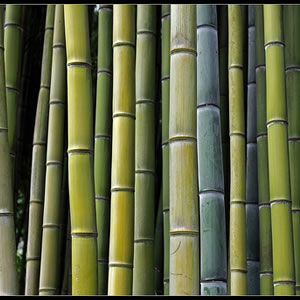- 5 reads

It’s the Big and Tall grass!
FACT: Bamboo can grow up to 60 feet tall, 10-12 inches in diameter, all within 5 years.
FACT: Bamboo is a grass and is harvested for both commercial and residential use.
FACT: Bamboo is incredibly versatile.
What’s new is old again. We’re just a little bit late in the game to learn about the advantages of bamboo. Bamboo is a useful and environmentally friendly product, which has been used in China for thousands of years for a large variety of products. For example, new shoots are canned for food. Mature plants are cut and used for furniture production, plywood, paneling, cabinets, countertop, scaffolding, and flooring to name just a few uses for this abundant and versatile plant. In flooring, we find that bamboo is a denser product than Northern Red Oak, and 50% more stable than Northern Red Oak, due to the fact it can be installed on a concrete slab below grade where other domestic solid hardwood flooring products can not.
Designers and Architects have found the flooring to be very unique, elegant in design, and have specified this material for many of their projects, such as homes, offices, hotels, retail environments, as well as high end yachts.
There are over 1,100 different species of bamboo. This particular type is called Moso, also known as “Hairy Bamboo.” Some bamboo shoots grow taller, wider, and harder than any other plants found in the Eastern Central region of China.
Most bamboo flooring products are finished in either high gloss, semi-gloss, or matte finishes, often using several coats of 100% solid UV cured German Treffert ceramic finish which makes it abrasion and slip resistant. Many manufacturers guarantee the finish with a 25 year residential wear layer warranty, as well as a 10 year commercial wear warranty.
What about spills and heavy traffic (maintenance)?
Look for products where tests have been done on abrasion resistance and chemical stain resistance to show that the finish is tough enough to withstand multiple chemical solutions left on for 24 hours with no affect, while abrasion tests should show minimal weight loss. Also look for products backed by a lifetime structure warranty which also covers delaminating. Maintenance is simple: vacuum or a damp mop as needed to remove loose dirt or grit before it can scratch the surface. For hard to remove spots use ammonia and water, citrus based solvent, or a urethane floor cleaner.
Can a Bamboo Floor Scratch?
Yes. However, the scratches are in the finish only and not in the material. Bamboo is a much denser product that Red Oak and other similar hard woods due to the manufacturing process.
How hard is it?
When tested according to the standard National Wood Flooring Association Test and the Janka Ball hardness tests, the flooring product demonstrates an average of 1320 pounds per square inch (PSI), comparing favorably with Northern Red Oak whose denseness is rated at 1290 PSI.
Can Bamboo Flooring be sanded?
Yes, bamboo products sand quite easily, and look for a 3/16 top layer which can most likely be re-sanded and finished 5 times depending on the depth of damage.
Can bamboo flooring be stained?
Yes, a professional finisher can stain this floor if it has not already been pre-finished. Manufacturers and distributors can also have your bamboo flooring professionally stained by the factory for an additional cost and with a minimum order of typically around 1500 square feet.
How much does it cost?
Due to the increasing demand for bamboo flooring, the cost has come down dramatically to be competitive with hard wood, and in many cases it is less expensive.
Furniture and Fabric:
When it comes to furniture and fabric there are whole new generations of products that have terrific advantages over wood. The durability and sustainability of the material is simply key for furniture and furnishings ranging from bureaus to beds. You can actually take bamboo from the floor surface up to the bed material and right on top with linens. Pure bamboo fiber is extremely smooth, and it has wicking and ventilation properties that make it a great eco choice for bedding. Pillow covers and sheets are silky smooth, but they don't slide loose when tucked in and resist wrinkling after a wash. Towels and even salad bowls and servers can take it to the next level. Check out Green Home Products and Furnishing to start browsing for a few eco alternatives.
Take your new perceptions on bamboo to the next floor level by checking out GREENandSAVE bamboo flooring options, where you can also find great information on installation and maintenance.

